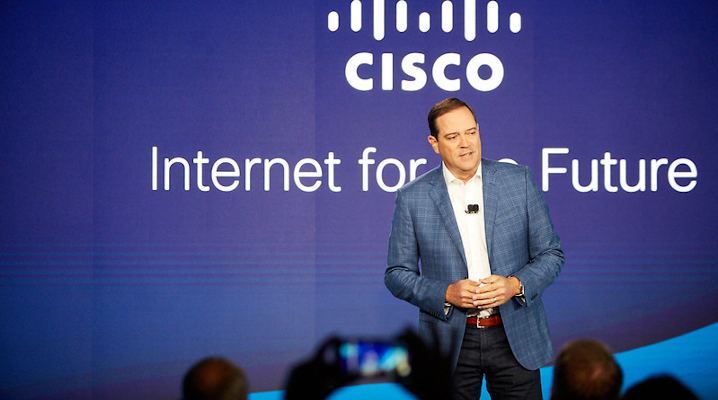 INFRA
INFRA
 INFRA
INFRA
 INFRA
INFRA
Cisco Systems Inc. delivered strong fourth-quarter results today, reporting double-digit order growth across all geographies and customer markets, but its stock fell slightly in extended trading as guidance was lower than expected.
The company reported a profit before certain costs such as stock compensation of 84 cents per share on revenue of $13.1 billion, up 8% from a year ago. That was better than expected, with Wall Street looking for earnings of 82 cents per share on revenue of $13.03 billion.
The full-year picture wasn’t quite so rosy, though, as Cisco broke even with sales of $49.8 billion, up just 1% from a year ago.
Even so, Cisco Chief Executive Chuck Robbins (pictured) was in an upbeat mood, saying the company saw “great momentum” with customers looking to modernize for greater agility and resiliency.
“The demand for Cisco technology is strong with our Q4 performance marking the highest product order growth in over a decade,” Robbins said in a statement. “With the power of our portfolio, we are well positioned to help our customers accelerate their digital transformation and thrive in a hybrid world.”
Cisco’s biggest business segment, Infrastructure Platforms, pulled in sales of $7.55 billion in the quarter, up 13% from a year ago and higher than expectations. The segment includes sales of Cisco’s ethernet switches and data center routers.
The Applications segment did less well, however, with sales falling 1% from a year ago, to $1.34 billion. Security revenue, meanwhile, rose only 1% from a year ago, to $823 million. Both units missed Wall Street’s expectations.
Cisco has battled against the well-documented supply chain challenges that have dogged the tech industry since the COVID-19 pandemic began last year, and the company responded to that during the quarter with what Cisco Chief Financial Officer Scott Herren said were “strategic price increases” on Aug. 7.
Herren told analysts on the call that Cisco was approaching brokers to try to secure extra supply of the components its products need, sometimes going to second sources. Unfortunately, he said, doing so increases the company’s costs. The company will continue to evaluate the situation, and could raise prices further, he added.
“We expect the supply challenges and cost impacts to continue through at least the first half of our fiscal year, and potentially into the second half,” Robbins said on the call. During its previous earnings call in May, Cisco had warned that it may face supply constraints until the end of 2021.
Still, Robbins said he had seen nothing to suggest that customers were ordering ahead of their needs. “We certainly think customers are placing orders further in advance because of lead times, which is just logical,” he explained. “When you see the order growth in Q4 and then you see the forecast pipeline that we see going forward, it would suggest there’s a fair amount of demand out there.”
Cisco saw strong momentum in its efforts at selling more software and subscriptions. It said $4 billion of its fourth-quarter revenue came from software, up 6% from a year ago, with subscription revenue up 9%. For the full year, software revenue rose 7%, and subscription revenue rose 15%.
Cisco was busy on the acquisition front during the quarter, announcing its intent to buy a company called Epsagon Ltd. that helps enterprises detect technical issues in their applications and identify the root cause. Epsagon will be folded into Cisco’s Applications business once that deal is done.
“It’s good to see Cisco on the growth path again after a challenging period,” said Constellation Research Inc. analyst Holger Mueller. “The not-so-good news is that Cisco sacrificed margin and its earnings per share is down. But in its current situation that’s probably still a good strategy and result. The better news is that Cisco has been able to deliver growth in its critical infrastructure business, even though its diversification into applications has stumbled.”
For the next quarter Cisco said it’s expecting an adjusted profit in the range of 79 to 81 cents per share, with revenue growth of 7.5% to 9.5%. Wall Street is looking for an adjusted profit of 81 cents per share on revenue of $12.84 billion for the first quarter, which would imply revenue growth of 7.7%.
The full-year forecast was more optimistic. For fiscal 2022 Cisco said it’s expecting an adjusted profit of $3.38 to $3.45, the midpoint of which is in line with Wall Street’s forecast of $3.41.
Pund-IT Inc. analyst Charles King told SiliconANGLE Cisco made a strong finish to a long year that has taxed the patience and resolve of many if not most companies. “Double-digit growth in product orders across all customer segments and geographies bodes well for the quarter ahead,” he added.
As for Cisco’s cautious guidance for the next quarter, King said while it may have upset investors it was both practical and sensible given the ongoing supply challenges it faces.
“The hopes that many had for a return to pre-COVID normality have been thrown into disarray by the Delta variant,” he said. “Since how that will impact on demand, markets and supply chains is still a bit of a work in progress, keeping a lid on expectations is the smart way to go.”
Support our mission to keep content open and free by engaging with theCUBE community. Join theCUBE’s Alumni Trust Network, where technology leaders connect, share intelligence and create opportunities.
Founded by tech visionaries John Furrier and Dave Vellante, SiliconANGLE Media has built a dynamic ecosystem of industry-leading digital media brands that reach 15+ million elite tech professionals. Our new proprietary theCUBE AI Video Cloud is breaking ground in audience interaction, leveraging theCUBEai.com neural network to help technology companies make data-driven decisions and stay at the forefront of industry conversations.